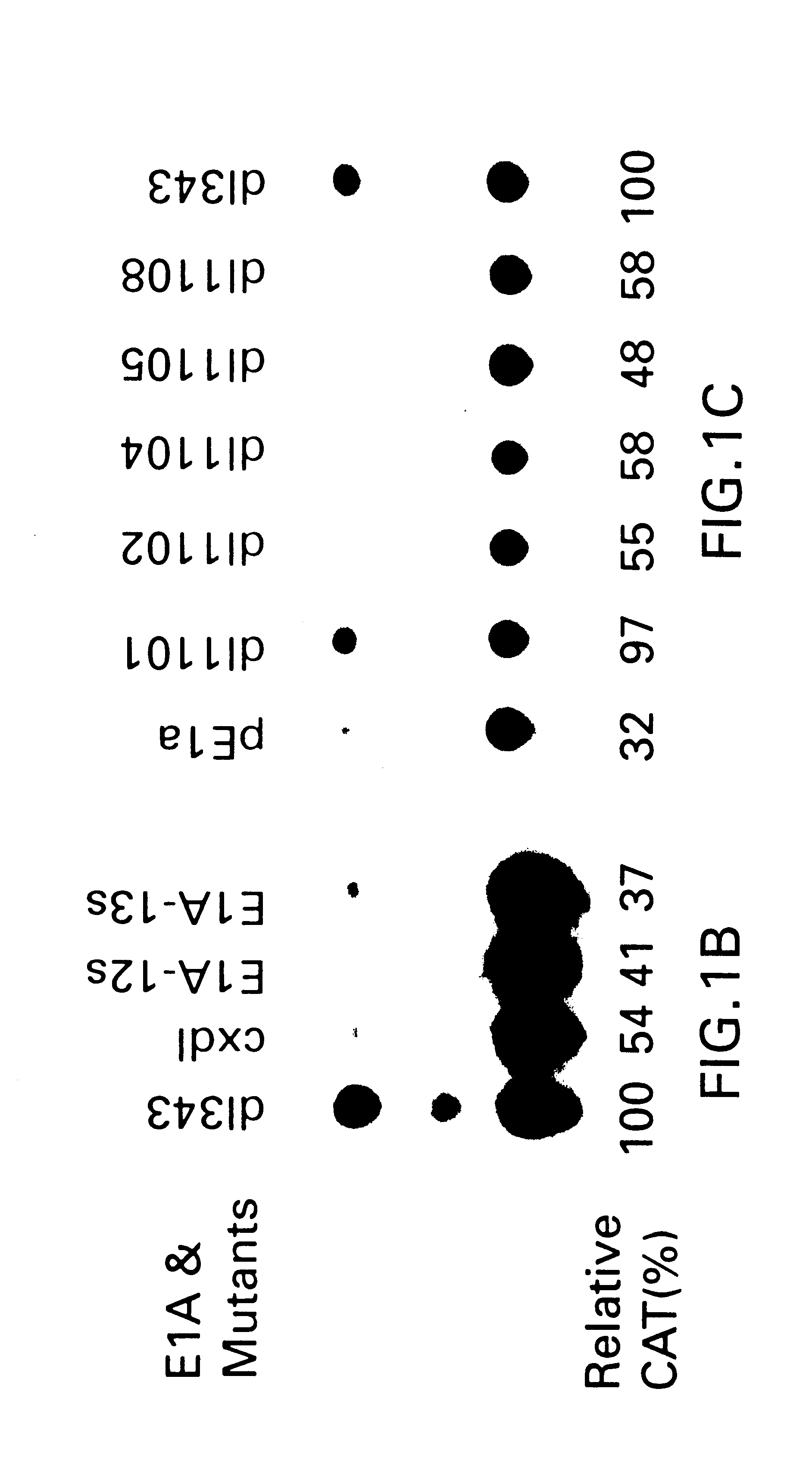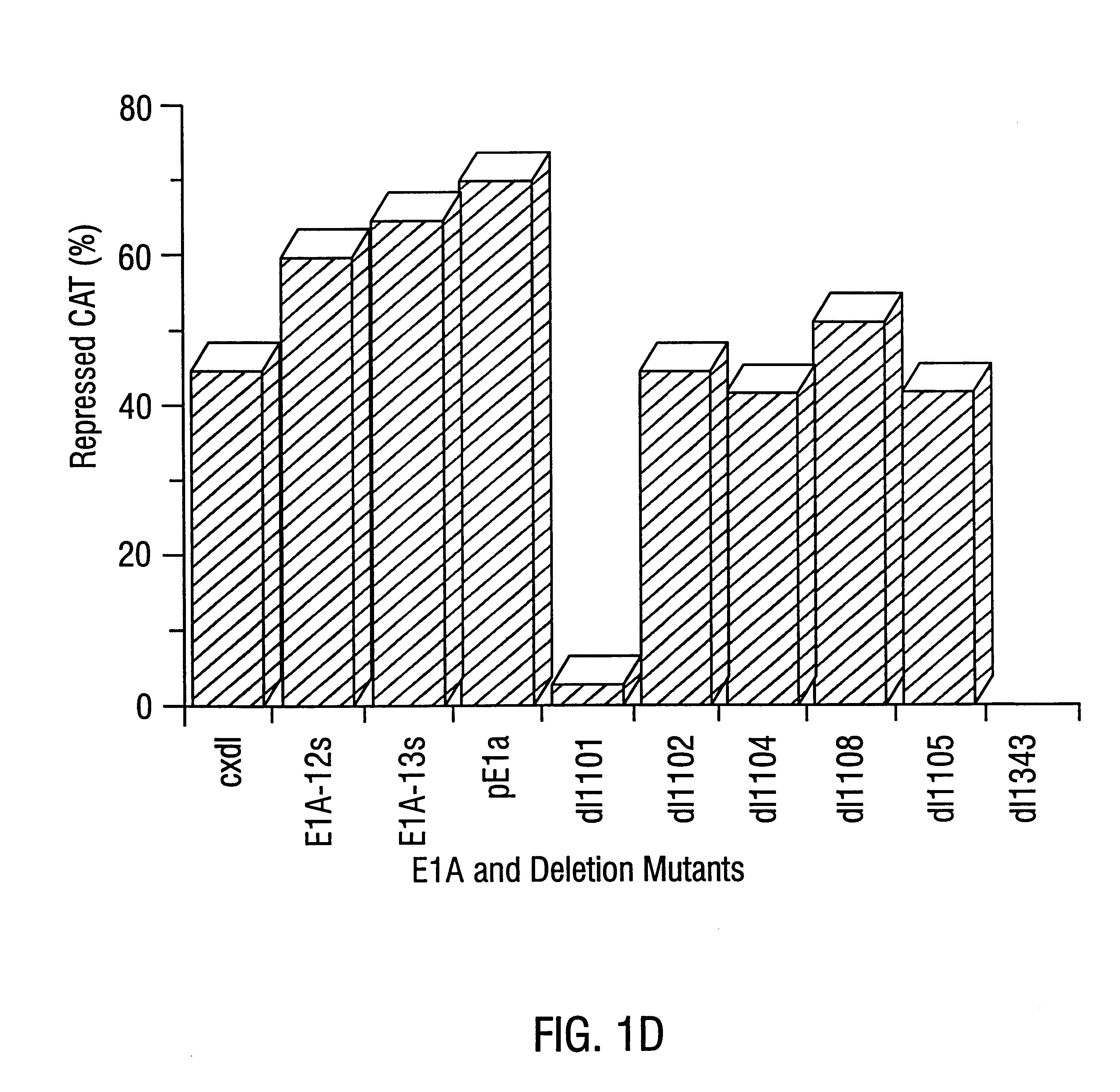Suppression of tumor growth using a mini-E1A gene
a gene and tumor technology, applied in the field of genetic constructs, can solve the problems of ineffective means of suppressing tumor growth, inability to fully express tumor growth,
- Summary
- Abstract
- Description
- Claims
- Application Information
AI Technical Summary
Problems solved by technology
Method used
Image
Examples
example ii
Delivery of DNA Into Oncogenic Cells Via Lipid-Based Complexes
One particularly useful way to use mini-E1A, E1A and / or LT to repress neu-mediated phenotypes is via the use of lipid-based complexes for carrying the suppressor's DNA into the oncogenic cells.
Preparation of Lipid-Based Complexes
Lipid-based complexes, such as cationic lipid complexes, which are efficient transfection reagents for the mini-E1A, E1A and LT genes for animal cells can be prepared using the methods of Gao et al. (1991) and of Huang and collaborators (cited above). Gao et al. describes a novel cationic cholesterol derivative that can be used for gene delivery. Complexes made of this lipid are reportedly more efficient in transfection and less toxic to treated cells than those made with other reagents such as Lipofectin. Exemplary lipids are a mixture of DC-Chol ("3.beta.(N-(N'N'-dimethylaminoethane)-carbamoyl cholesterol") and DOPE ("dioleoylphosphatidylethanolamine"). The steps in producing these complexes are...
example iii
In vivo Use of Mini-E1A Gene Products
In an initial round of in vivo trials, inventors have used a mouse model of human cancer with the histologic features and metastatic potential resembling tumors seen in humans (Katsumata et al., 1995) and treated these animals with mini-E1A to examine the suppression of tumor development.
These studies are based on the discovery that mini-E1A has tumor suppressor activity, as noted above. The Examples above further show that E1A inhibits the growth of cancer cells and furthermore sensitizes cancer cells to chemotherapeutic drugs. The current example uses mini-E1A, either alone or in combination with chemotherapeutic drugs and / or emodin-like tyrosine kinase inhibitors, to provide a useful preventive and therapeutic regimen for patients with cancers.
Two groups of mice of a suitable cancer model are treated with doses of mini-E1A in combination with anti-cancer drugs and / or emodin like tyrosine kinase inhibitors starting at 6 weeks of age. Several co...
example iv
Use of a Mini-E1A Gene (E1AN80) to Suppress Tumorigenesis in a Long-Term Survival Study
Long-term survival studies to assess the tumor suppressor activity of mini-E1AN80 have now confirmed the ability of mini-E1AN80 to suppress tumor formation in mice as described in Example 1 (see FIG. 7). Results from both of these studies thus indicate that mini-E1AN80 appears to be useful, as is E1A, for tumor suppression in vivo.
As described in Example 1, the mini-E1AN80 construct contains a portion of the N-terminus, the CR1 domain and the C-terminus of the full-length E1A polypeptide (FIG. 2A). Mini-E1AN80 lacks the central portion of E1A from amino acids 81 to 185 which includes the CR2 and CR3 domains.
The protocol for tumor engraftment and lipid-DNA complex formation for the long-term survival studies were performed as described above. Five mice were used in each group. In these studies, the ovarian carcinoma cell line SKOV-3.ip1 was used to induce tumors in the mice. SKOV-3.ip1 is derived f...
PUM
| Property | Measurement | Unit |
|---|---|---|
| Time | aaaaa | aaaaa |
| Time | aaaaa | aaaaa |
| Chemotherapeutic properties | aaaaa | aaaaa |
Abstract
Description
Claims
Application Information
 Login to View More
Login to View More - R&D
- Intellectual Property
- Life Sciences
- Materials
- Tech Scout
- Unparalleled Data Quality
- Higher Quality Content
- 60% Fewer Hallucinations
Browse by: Latest US Patents, China's latest patents, Technical Efficacy Thesaurus, Application Domain, Technology Topic, Popular Technical Reports.
© 2025 PatSnap. All rights reserved.Legal|Privacy policy|Modern Slavery Act Transparency Statement|Sitemap|About US| Contact US: help@patsnap.com



